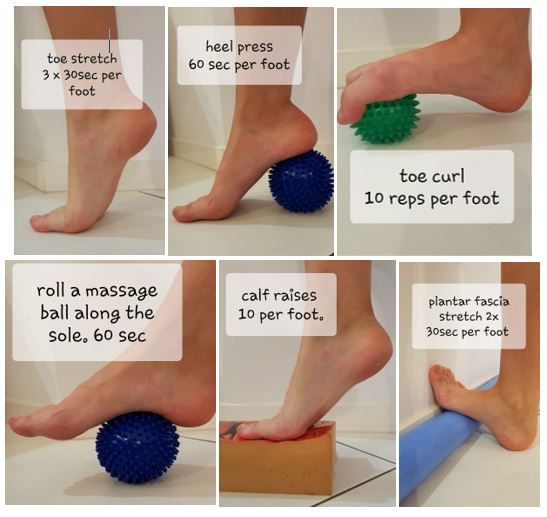The plantar fascia is a thick, connective band that attaches from your heel to your toes, supporting the arch of your foot. Its action is pretty cool, at heel strike with each step, the plantar fascia is put on a stretch, much like an elastic band pulled tight.
The symptoms of Plantar Fasciitis
Pain is usually experienced on the bottom of the heel but it can occur anywhere along the band and can even extend into the toes. This is often described like stepping onto a sharp stone, but a dull, radiating ache is also common. The pain is almost always worse first thing in the morning or after sitting for a long time, when the fascia has been rested in a shortened position. Any strain on the calf, such as climbing stairs can also exacerbate the facial symptoms. As the inflammation becomes more chronic, pain can occur all day long.
Who is a greater risk of developing Plantar Fasciitis?
- Overweight people because there is more strain on the tissues; this includes pregnant women.
- People who work on their feet all day, especially if their foot wear does not support the arch of the foot or correct the heel roll.
- Too much to soon; embarking on a new run programme without gradually building to longer distances or going out on a long hike without the appropriate training and often in new untested shoes.
- People with either very high arches or very flat feet.
- Active men and women between the ages of 40 and 70 are at highest risk, with woman being more prone than men.
So how do you treat Plantar fasciitis
If your pain is acute (newly experienced within the last 24 – 48 hours), simply resting off your feet and icing the fascia will probably stop it in its tracks. However more chronic inflammation may need a bit more robust treatment. It might mean changing your activity, it would certainly be appropriate to have your footwear checked and changed if required. Arch supports in your shoes like in-shoe orthotics will help to rest the arch. Non-steroidal anti-inflammatory drugs may be required to settle the inflammation or in more severe cases a steroid injection may be indicated. However, in just about all cases, physiotherapy is probably your best and first port of call. Your physio will assess your foot wear, your gait pattern, the way you transfer weight during gait and any muscle imbalances that may contribute to the problem. At Sunshine Coast Health Services, I also use a device called a Sanakey which is a transcutaneous electro stimulator; this devise uses an electrical impulse very similar to the nerve impulse your body transmits. The electrical impulse is interpreted by your body and through a bio feedback system sends information back to the devise which will then modulate it’s impulse. This communication goes back and forth until inflammation is reduced, swelling is dissipated and pain settles. Most importantly physiotherapy is not just about clearing your symptoms but goes deeper into discovering the cause and making the necessary adjustments to prevent reoccurrence. Plantar Fascia pain can be difficult to treat and if left alone can niggle you for a long time. Save yourself the pain and frustration by making an appointment today and let us take care of your feet.
Visit our web site http://schealthservices.com.au or call on 5363 0288 to start your journey from pain today.
Follow these simple Plantar Fascia exercises to get you started today and speed your recovery.

